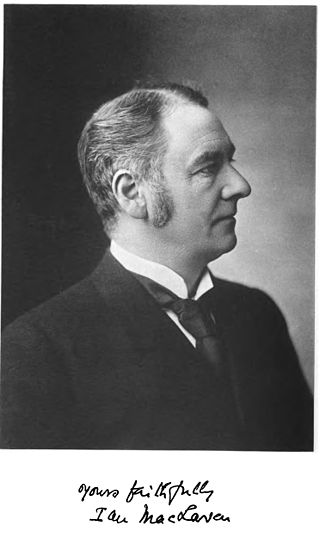
John Watson, was a minister of the Free Church of Scotland. He is remembered as an author of fiction, known by his pen name Ian Maclaren.

The Kailyard school is a proposed literary movement of Scottish fiction; kailyard works were published and were most popular roughly from 1880–1914. The term originated from literary critics who mostly disparaged the works said to be within the school; it was not a term of self-identification used by authors alleged to be within it. According to these critics, kailyard literature depicted an idealised version of rural Scottish life, and was typically unchallenging and sentimental.

Fetteresso Castle is a 14th-century tower house, rebuilt in 1761 as a Scottish Gothic style Palladian manor, with clear evidence of prehistoric use of the site. It is situated immediately west of the town of Stonehaven in Kincardineshire, slightly to the west of the A90 dual carriageway. Other notable historic fortified houses or castles in this region are Dunnottar Castle, Muchalls Castle, Fiddes Castle, Cowie Castle and Monboddo House.

Catterline is a coastal village on the North Sea in Aberdeenshire, Scotland. It is situated about 5 miles (8.0 km) south of Stonehaven; nearby to the north are Dunnottar Castle and Fowlsheugh Nature Reserve. Other noted architectural or historic features in the general area include Fetteresso Castle, Fiddes Castle, Chapel of St. Mary and St. Nathalan and Muchalls Castle.
Crawton is a former fishing community on the southeast Aberdeenshire coast in Scotland, deserted since 1927.
The Fetteresso Forest is a woodland that is principally coniferous situated in the Mounth range of the Grampian Mountains in Aberdeenshire, Scotland. The forest has a number of prominent mountain peaks including the Hill of Blacklodge and Craiginour peak. A good overlook for viewing the forest from the north side lies on an unnamed tarmack road which leads north from the Slug Road to the Raedykes Roman site. The Cowie Water flows through and drains much of the forest. To the north of the easternmost part of the forest is the archaeological site Raedykes Roman Camp, as well as Cowton Burn. The Slug Road runs along much of the northeast perimeter of Fetteresso Forest.

Auchenblae is a village in the Kincardine and Mearns area of Aberdeenshire, formerly in Kincardineshire, Scotland. The village was known for its weavers, a whisky distillery and the annual Paldie's Fair horse market.
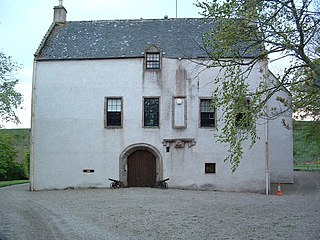
Allardice Castle is a sixteenth-century manor house in Kincardineshire, Scotland. It is approximately 1.5 kilometres north-west of the town of Inverbervie. The Bervie Water flows around Allardice Castle on both sides. Allardice may be viewed as one of a chain of coastal castles; to the north are Dunnottar Castle (ruined), Fetteresso Castle, Cowie Castle (ruined) and Muchalls Castle. The castle is a category A listed building. Allardice castle was the chief seat of the Barons of Allardice, an ancient family who first appear in an 1197 charter. Since 1542 many alterations and changes have been made to the original structure.

Drumtochty Castle is a neo-gothic style castellated mansion erected in 1812 approximately three kilometres north-west of Auchenblae, Kincardineshire, Scotland. This building stands on the southern edge of Drumtochty Forest.

The Kirktown of Fetteresso is a well-preserved village near Stonehaven, Scotland. In the planning area of Kincardine and Mearns, Aberdeenshire, this village contains many very old stone residential structures as well as the Church of St. Ciarans and its associated graveyard. The Carron Water winds through the Kirktown of Fetteresso, and Fetteresso Castle, a listed building, lies at the northwestern verge. Some of the earliest area prehistory has been found nearby on the Fetteresso Estate grounds, where there have been archaeological finds from the Bronze Age.

Bowdun Head is a headland landform on the North Sea coast approximately one kilometre south of Stonehaven, Scotland.(Ordnance Survey, 2004) Slightly to the north is another headland, Downie Point. Somewhat to the south along the coast is Dunnottar Castle on the far side of the bay of Castle Haven. Other historic structures in the general vicinity include the Stonehaven Tolbooth, Fetteresso Castle, the Chapel of St. Mary and St. Nathalan and Muchalls Castle. There is considerable prehistory associated with the local area including a Pictish hill fort on the sea stack of Dunnicaer immediately to the north, and Bronze Age archaeological sites at Fetteresso and Spurryhillock, both somewhat inland of Bowdun Head.

Downie Point is a prominent headland located at the southern edge of Stonehaven Bay in Aberdeenshire, Scotland. From the Stonehaven Harbour, there is a panoramic view of this cliff landform, especially from the tip of Bellman's Head.
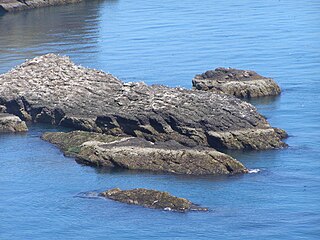
Craiglethy is a small island/skerry off Fowlsheugh on the east coast of Aberdeenshire, Scotland in the North Sea. As it is part of Fowlsheugh, it is an SSSI, with many seabirds and seals living on it. It is also one of the few islands on the east coast of Scotland, along with Mugdrum Island and Inchcape, apart from the Islands of the Forth.
Bonnie Brier Bush may refer to:
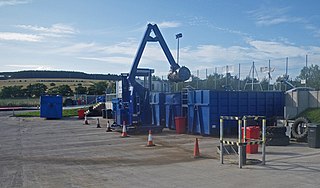
Red Cloak is an industrial area of Stonehaven, Aberdeenshire, Scotland. The site's settlement history is associated with events at the nearby Chapel of St. Mary and St. Nathalan. In current times Red Cloak is primarily an industrial dominated land use that includes Aberdeenshire Council recycling and refuse disposal functions. Earliest area prehistory is evidenced by Bronze Age finds at Fetteresso Castle and Ury House.
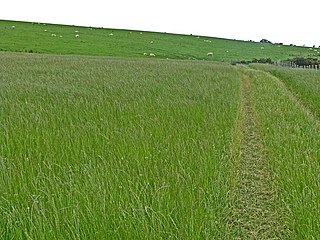
Bogjurgan Hill is an elevated landform at the southern verge of the Fetteresso Forest in Aberdeenshire, Scotland. Its top is at an elevation of 299 metres (981 ft) above sea level. Historical features in this region of Kincardineshire include Fetteresso Castle, Drumtochty Castle and Muchalls Castle.
This is a list of bestselling novels in the United States from 1895 through 1899, as determined by The Bookman, a New York–based literary journal. Without the international copyright law which came into force in 1891, these volumes could have been printed and published by anyone, the change in this state of affairs made it possible to compile accurate sales figures.
Events from the year 1894 in Scotland.

Beside the Bonnie Brier Bush is a book of short stories by Ian Maclaren published in 1894. It became a hugely popular bestseller. It is considered to be part of the Kailyard School of Scottish literature. A kailyard or kailyaird (kale) is comparable to a cabbage patch and refers to a kitchen garden as might be found adjacent to a cottage. The title, Beside the Bonnie Brier Bush, references the Jacobite song "There grows a bonnie brier bush in our Kailyard". Publishers Weekly reported it as the bestselling novel in the U.S. during 1895 and the 10th bestselling novel during 1896.
There Grows a Bonnie Brier Bush, originally The Bonnie Brier Bush, is a traditional Scottish music folk song. It was included with expanded lyrics in Burns' Scots Musical Museum in 1797. Ian Maclaren included part of the song lyrics in the preface to his bestselling collection of stories set in Scotland, Beside the Bonnie Brier Bush (1894). A series of theatrical versions and the 1921 film The Bonnie Brier Bush followed.












